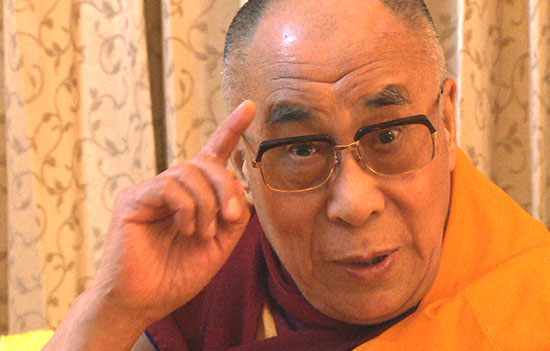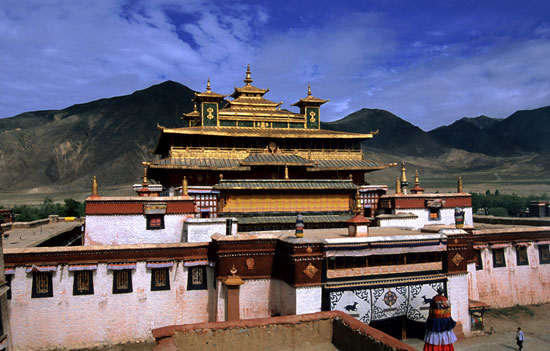- Know about the Indian
Roots of Tibetan Buddhism and see film.
The vast universities of
Eastern India had hundreds of teachers and students who came from across India
and from the many countries of Asia that had embraced Buddhist philosophy. The
greatest of these was at Nalanda. Here there was a spirit of vibrant
intellectual thought, a climate of discussion and debate. These were the roots
of the Buddhism which travelled from here to Tibet.
The scholars of Nalanda made outstanding
contributions to numerous fields of study. The many acharyas or great masters
at Nalanda, authored hundreds of treatise in various fields; on philosophy,
metaphysics, psychology, logic, medicine, astrology, arts, literature and other
subjects.
In the words of Dr. Jeffrey Durham: “One of the most important universities in
the world was developed not in the medieval west, but right here in India. And
here I am referring to the university consortium of Nalanda, Vikramshila, Somapura,
Odantpuri – all of these universities were instrumental in producing people who
are capable of understanding and articulating what it means to have universal
knowledge, knowledge that applicable, across cultures and in across times.”
In the words of H. H. the Dalai Lama in the film: “In Buddhism, as also in Jainism, we have no concept of a creator. So one’s own salvation must be achieved through one’s own effort. Now the main obstacle in the path to salvation, is ignorance. So logically, the antidote of ignorance is knowledge, not prayer”.
The study at Nalanda was of life itself and
what is reality. It was based not upon faith but on unshakable logic and
pursuit of the truth. The study was of our minds, are perceptions and what is
knowledge itself? The intellectuals here analyzed the qualities which led to
Enlightenment and sought to create a logical path which could lead us to
Buddhahood. A path which would work for all.
There was no written script
in Tibet till the 7th century. The acceptance of the Buddhist faith entailed the
understanding of subtle philosophic concepts and profound commentaries. This transfer
of knowledge would not have been possible without translating and writing it
down. A very sophisticated language and a script capable of preserving this
knowledge had to be formulated.
In the words of H. H. the
Dalai Lama in the film: “Tibetan script is very much a copy and very much
similar to Sanskrit.
Once Buddhism reached Tibet,
translations started. There was no vocabulary in Tibetan to translate Buddhist
knowledge and traditions. So new words were created. So therefore, eventually
Sanskrit vocabulary or Sanskrit terminology and Tibetan terminology go exactly
the same”.
 His Holiness the Dalai Lama,
speaking to the film-maker.
His Holiness the Dalai Lama,
speaking to the film-maker.
In
the words of Geshe Samten: “The
Tibetans scholars made a special effort to translate the Sanskrit works into
Tibetan language by developing the Tibetan language in such a manner that it could
retain the thematic meaning, as well as the literal meaning with the great
precision.
The translations are done word by word and
sentences by sentences. Therefore, the precision that is maintained in Tibetan
is unparalleled”.
In the words of Prof. Samdhong Rinpoche: “Acharya Shantarakshit was the first person who
established Buddhism in Tibet. He taught the Tibetan people to learn Buddhism
not by faith but by reasoning, by logic and by analyzing the things for oneself.
The Buddha had said that we should not believe that which he said, but to
understand it oneself, through analysis and through the rational mind”.
Most of the major
monasteries, of all the Tibetan traditions, were re-established in India. These
monastic Institutions, where erudite masters teach, have attracted scholars from
around the world, who have came to India to study here.
In the words of Geshe Dorji Damdul: “This knowledge is pure knowledge. It has nothing to do with dogma; it
has nothing to do with religion as such. So therefore, I call it a legacy of
India, the legacy of the world. So it must not disappear, it must remain for
long”.
In the words of H. H. the
Dalai Lama in the film: “Therefore, when I meet an Indian, I always say you are
traditionally our Guru. We are chela.
You Indian our Guru. Then also I mention we Tibetans not only Indian Guru’s
chela, but also quite reliable chela. That means, in Guru’s own land Buddha
Dharma had lots of ups and downs. During these period, we your chela kept your
knowledge intact, through centuries. So we are quite reliable chela.
To see VIDEO of film 49 minutes
To see VIDEO of India Habitat Program 1 hour
All pictures are courtesy and copyright Benoy K Behl.
The film is shot extensively in Tibet,
Kalmykia in European Russia, Ladakh, Spiti, Arunachal Pradesh, Nalanda,
Bodhgaya, Sarnath and Karnataka. Benoy K Behl, world-famous Buddhist scholar,
art-historian, film-maker, photographer and author, is the director and the
narrator of this film.
Also read
1. Pictures of Nalanda
University
2. Vikramshila
University
3. Bodhgaya Temple 1
4. Bodhgaya Temple
part 2
and part 3
5. Rajgir
6. Ajanta
Caves
7. Buddhist
Caves Ellora
8. Lord
Indra in Buddhism
 Samye Monastery Tibet.
Samye Monastery Tibet.